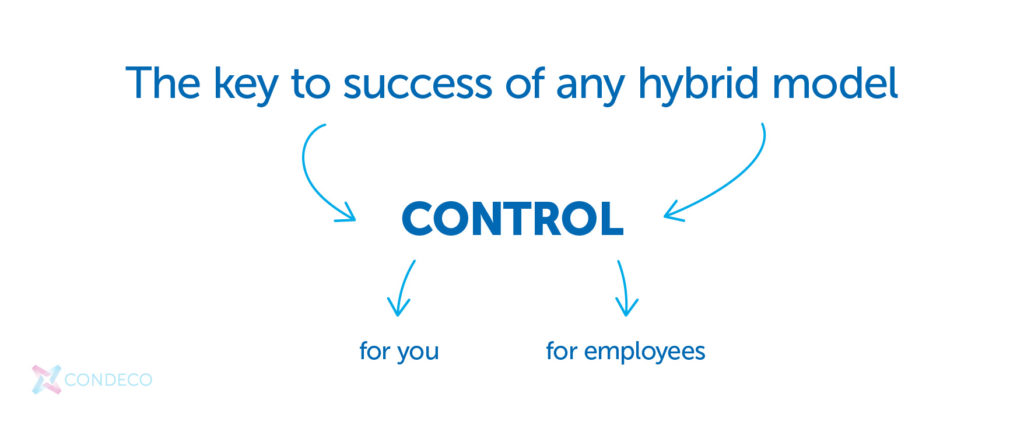
Your business has made a strategic decision to adopt a flexible working approach. Specifically, you’ve chosen the hybrid work model, a progressive way of working that combines the comfort of home with the collaborative environment of the office. This model not only promotes work-life balance but also enhances productivity and job satisfaction.
During the pandemic, companies discovered that this model could work and drive positive productivity and staff morale advantages. However, you will still face challenges when making the work model a standard part of your company.
Here, we look at some of the biggest barriers to creating a successful hybrid model work environment and how you can overcome these challenges and win. Let’s make the hybrid model work for your business.
Principles for a new way of working
The key to the success of any hybrid model is control: for you and your employees. Digital automation helps everyone spend less time sorting out their hybrid workday and more time adding value to the business. It allows employees to book a desk or meeting room and plan their day accordingly so they can focus on more productive tasks. Colleagues need the control to come together and collaborate without spending hours dealing with technology or coordinating schedules. As leadership, you need control to manage capacity, maximize office resources, optimize the office experience, and get ROI from your office space.
If you achieve all these, hybrid working will bring innovation and employee satisfaction to your company and drive business growth. You’ll also create a positive, happy experience that makes the office a joy to visit.

Achieve all these and hybrid working will bring innovation and employee satisfaction to your company and drive business growth. And you’ll create a positive, happy experience that makes the office a joy to visit.
Planning office space
Why it’s a challenge:
One of the advantages of flexible working is being able to downsize your offices to match the reduced number of employees who go there every day. That still leaves the challenge of how many desks and meeting rooms to make available. Too many desks will make your office space feel empty and lack energy. Too few, and you run the real risk of arguments over who sits where and why no rooms are available for vital strategy sessions.
How to avoid:
The key to this challenge is controlling the situation through smart workspace scheduling solutions. Allowing people to easily see what’s available and book the desks and rooms they need will inspire confidence in your hybrid work solution. The data generated will also give crucial insight into working patterns and office usage, helping you plan better for the future.
A lack of clarity
Why it’s a challenge:
Flexible working policies can be confusing, especially as everyone has their own unique circumstances. These policies must cover issues such as how many days are spent in the office and at home. You need to decide if there is a time when everyone needs to be available. Rules about the expected number of days in the office may also need to be outlined.
How to avoid:
As with any good policy, you need to get feedback from the people it will affect first — your staff. Find out what matters to them and how flexible working could help them be more productive. Once you have this information, you can convert it into policies that offer certainty and an optimal way for your business to operate under a hybrid work model.
Keeping teams connected
Why it’s a challenge:
Connecting your employees at home with their colleagues in the office can be complicated, no matter how small or large the teams involved. Collaboration is vital for innovation, with networking and relationship building acting as the glue that binds a company together. How should they communicate and collaborate on a day-to-day basis? You can’t expect workers to find a way through these issues alone. So, how can you encourage people to visit the office and collaborate there?
How to avoid:
Many tools, such as Zoom, Slack, and Teams, are available to enable effective communication. Your previous experience with pandemic lockdowns should have given you a good idea of what works. Discuss with your teams their needs and choose the most appropriate tool. Then, ensure all employees are on the same page using the tools so no one is left out. Some training might be required for employees who are more used to traditional forms of work. When in the office, facilitate collaboration with tools that make it easy to book rooms, know other people’s schedules, and synchronize calendars. It will make a big difference when it comes to encouraging on-site work.

Employee wellbeing
Why it’s a challenge:
It’s easier to look after employees’ physical and mental health when they are all gathered in one building every day. However, it’s more of a challenge when some are at home or even in another country. In particular, remote work can have an impact on mental health as some can feel isolated or ignored. Younger generations, in particular, may have a sense of being trapped. That’s why a balanced well-being approach is not just important, it’s crucial. It combines the benefits of remote work with the office’s social interaction, learning, and development, reassuring everyone about the company’s commitment to their health and happiness.
How to avoid:
Good management is key. Ensure managers responsible for regular staff check-ins ask how they’re doing, how they’re coping with the new working arrangement, and whether they need anything else to help. Leadership must be trained to spot signs when things might be going wrong with their team members.
Unconscious bias
Why it’s a challenge:
Research by MIT has shown that those who work in an office are more likely to be evaluated, get promoted, or receive pay raises than those who work remotely over computer screens or visit the office less often. This can become a real issue when people feel they need to be in the office to get ahead with the company.
How to avoid:
Make sure your company has the right tools, structure, and training to ensure fairness is provided to all employees regarding performance evaluations. Unconscious bias is hard to tackle due to its implicit nature. Still, it’s crucial that those working remotely or hybrid feel they have an equal opportunity to succeed to those working in the office full-time. Keep a close eye on any correlation between where someone works and how they’re rewarded. Let employees know they’re measured on their output, not where they work. Present your office as a place for collaboration and adding value rather than sending emails all day.
Building a culture
Why it’s a challenge:
One of the most popular objections to flexible working is its impact on building a strong, unified company culture. How can you get employees to embrace the same values when they’re spread throughout the country? What can replace the good old-fashioned get-together, shared celebration, and gossip in the office kitchen?
How to avoid:
In these evolving times, adapting your company culture to accommodate the hybrid working model is crucial. This doesn’t mean discarding everything but making adjustments to ensure it remains relevant for all your employees. You can still share celebrations, whether virtually or in person. And, when circumstances permit, you can still bring everyone together in a physical space on special occasions. By utilizing your office space effectively, every visit can feel like a team-building day that nurtures and sustains your culture. Tailor it to your needs, and you’ll find that people are eager to come together, collaborate, and foster relationships. In fact, your culture might even grow stronger as a result.
Lack of buy-in
Why it’s a challenge:
If senior management doesn’t believe it will work, your plans for a hybrid working model may not even get off the ground. It can be quite a large change for everyone, but for the hybrid model to succeed, everyone must be on board from every stratum of your organization.
How to avoid:
First of all, don’t just dismiss their concerns. Try to understand them. And don’t sell the new flexible arrangement as a reaction to a problem. Provide proactive arguments in favor of hybrid working. Have examples of how it worked for similar organizations and some success stories when productivity improved from remote working. Remind senior leadership and decision-makers of all available tools to meet their concerns and emphasize the bottom line. If hybrid working could make the company more profitable, you already have a winning argument for flexible working.
Hybrid work is here to stay
Flexible working is here to stay, and every challenge to making it work has a solution, often enabled by technology. Take control and check out the worktech so that everyone has the certainty to collaborate with confidence and you can make the most of the opportunity.





